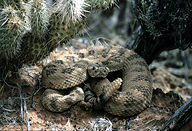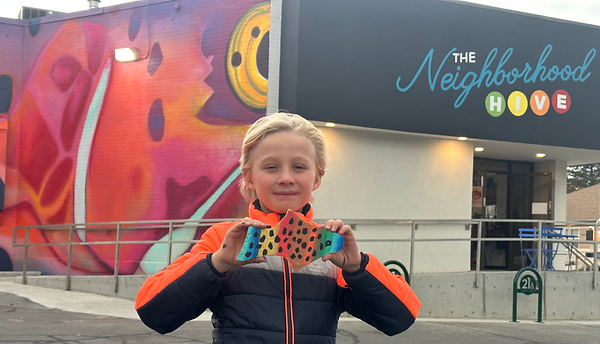

A celebration of the
Bonneville cutthroat trout

Salt Lake City, Salt Lake County
Located at The Neighborhood Hive in Salt Lake City, the Bonneville Cutthroat Trout Mural is a tribute to Utah’s state fish and a symbol of conservation success. This massive 120-foot mural was the pilot project to celebrate local wildlife through public art. The Bonneville cutthroat trout, once thought to be extinct, has made a remarkable comeback thanks to restoration efforts led by Utah’s Division of Wildlife Resources and conservation partners. This mural not only highlights the species’ beauty but also serves as a reminder of the importance of protecting native fish, restoring waterways, and preserving Utah species.

Utah is home to many fish species, but none are as iconic as Utah's own state fish, the Bonneville cutthroat trout. The Bonneville cutthroat is one of Utah’s only native trout species, and has existed in the Bonneville Basin since long before humans came around. Indigenous people in this area surely utilized cutthroat as a primary food source. Early Mormon settlers also relied on these native cutthroat to get them through the first few years.
Bonneville cutthroat however were the victim of wide-spread over-fishing, competition from introduced non-native fish, and habitat degradation. So by the 1950s, native “Bonnies” were thought to effectively be extinct. Thankfully, after their eventual rediscovery in the 1970s in Utah’s Deep Creek Mountains, and through monumental restoration efforts, the the "Bonnies" have been on the rebound and now thrive through much of their native range.

Bonneville cutthroat trout offer excellent angling opportunities for those interested in fishing for them, and they help balance ecosystems by preying on smaller bait fish and various invertebrate life. They exist today as a symbol of resilience and act as a reminder about the vulnerability of Utah’s native fish and the need for Utahns to do our part in preserving their survival through proper care and conservation.
Have Fun and Help Protect Utah’s Native Cutthroat Trout with the Utah Cutthroat Slam

Bonneville cutthroat trout offer excellent angling opportunities for those interested in fishing for them, and they help balance ecosystems by preying on smaller bait fish and various invertebrate life. They exist today as a symbol of resilience and act as a reminder about the vulnerability of Utah’s native fish and the need for Utahns to do our part in preserving their survival through proper care and conservation

The Utah Cutthroat Slam is a challenge to catch, photograph and released at least 1 of each of Utah’s 4 cutthroat trout subspecies in their native waters. Since 2016, the program has raised more than $100,000 for cutthroat conservation in Utah. Register here to start the challenge!
This Wildlife Walls project was made possible through key partnerships.
In partnership with local organizations and a crowdfunding effort, Wildlife Walls installed a 120-foot Bonneville cutthroat trout mural at the Neighborhood Hive Market in Salt Lake City in 2022. To launch the project, the Bonnie Ball Street Festival was hosted at the Neighborhood Hive to celebrate this and other local species with art, face-to-face wildlife encounters and conservation education. This mural is part of this statewide project to install monumental murals in every county of Utah. A QR code is installed on each mural to educate visitors about the species and provide recommendations for nearby firsthand wildlife encounters.







The Bonnie Wall
Designed and installed by Chris Peterson Studio
Our Pilot Project for Wildlife Walls
Utah Wildlife Walls began as a collaboration between artist Chris Peterson, writer Brett Prettyman and the Utah Wildlife Federation. They teamed up in 2022 to design and install an epic Bonneville cutthroat trout mural at the Neighborhood Hive in Salt Lake City.
The mural was designed and installed in October 2022 by Chris Peterson Studio. It was created to highlight the Trout in the Classroom program available to Utah's schools through a partnership with Trout Unlimited and Utah Division of Wildlife, From 2022-2025, the market hosted one of these trout tanks for patrons to enjoy and learn about this native species.





From the Artist
“The Bonneville cutthroat mural began as a way to highlight and celebrate a beloved local species, but we soon found out that it also provided an ideal backdrop for wildlife education and community building. The Bonnie Ball showcases a few of the many opportunities to engage kids and adults alike around the celebration of and learning about wild creatures." -chris peterson




Community Engagement @ The Bonnie Ball


On October 22, 2022, in partnership with the Neighborhood Hive, UWF and multiple partners, we hosted the First Annual Bonnie Ball Street Festival. With approximately 500 attendees showing up on a stormy day, we recognized community engagement potential of pairing large-scale murals with wildlife education and conservation outreach approaches.
While planning the event and mural, we recognized that many of Utah's wildlife species could be celebrated similarly. The success of the Bonnie Ball led us to refine and articulate the vision of Wildlife Walls to celebrate Utah's unique species with large scale murals across the state.
Ongoing Wildlife Engagement & Education
Since the first Bonnie Ball, the Neighborhood Hive and a variety of partners have made this community event an annual event with unique wildlife encounters, vendors, art activities, conservation education and kids fishing activities. Between 2022-2025, the mural and trout tank inside provided multiple education and community building opportunities, including student field trips with guest DWR biologists to trout-focused community art projects, and a series of community flytying nights.

Celebrating Utah's wildlife with big art and wildlife encounters across the state on the Wildlife Walls Mural Trail.

Where to find Bonneville cutthroat trout
The native range of the Bonneville cutthroat extends across much of Utah, reaching as far north as Willard and nearly as far south as St. George. These trout inhabit many small creeks along the Wasatch Range, as well as major rivers like the Weber and Provo and their tributaries. For the rural explorer, Bonnies can even be found in the Deep Creek Mountains near the Utah-Nevada border, where they were originally rediscovered. Any body of water with cold enough water that flows year round and provides them with protection and food can make a perfect habitat for these trout.
We encourage practicing catch-and-release for these special, often restored populations. Proper fish-handling techniques can greatly improve their chances of survival. Keep your fish in the water as much as possible, and wet your hands before handling them to remove the hook, take photos, and release them. Using a rubber net helps protect their slime coat, and minimizing their time out of the water will further ensure their survival. Thank you for doing your part to protect and care for these beautiful native trout!
-
Mill Creek: One of the best places to observe Bonneville cutthroat is Mill Creek near Salt Lake City. A quick trip up Millcreek Canyon offers a beautiful escape from the city, and checking the creek near roadside picnic areas often provides excellent opportunities to spot these trout
-
Big Cottonwood Creek (Big Cottonwood Canyon): Flowing through the Wasatch Mountains, Big Cottonwood Creek is home to a thriving population of Bonneville cutthroat trout. Grab your fly rod, bring a picnic, or just pull off the road to see these fish swimming in the creek.
-
Little Cottonwood Creek (Little Cottonwood Canyon): Originating near Alta, Utah, this cold, fast-moving creek supports Bonneville cutthroat trout. The best chances for spotting them are near shaded, slow-moving pools.
-
Little Dell Reservoir: Located about 13 miles east of Salt Lake City. Always familiarize yourself with local fishing regulations and guidelines before visiting.
-
Bison @ Antelope Island State Park: Located within the Great Salt Lake, this park is home to up to 700 bison. Visitors can hike, bike, or drive around the island. The annual Bison Roundup each fall offers a unique chance to witness the management of the herd.
-
Moose @ Silver Lake (Big Cottonwood Canyon): A short drive from Salt Lake City, Silver Lake provides accessible trails where moose sightings are common, especially during early morning or late evening hours.
-
Sandhill cranes, beaver, bobcats, etc. @ Swaner Preserve and EcoCenter: Located near Park City, this 1,200-acre nature preserve offers guided tours and educational programs, with moose, beaver, amphibians and other wildlife frequently spotted in the wetlands and meadows.
-
Rattlesnakes @ Red Butte Garden: Located in Salt Lake City, Red Butte Garden offers a natural habitat where visitors might encounter rattlesnakes. Be extremely cautious and stay on designated paths, especially during warmer months when snakes are more active. Rattlesnakes are a protected species.
Nearby Wildlife Viewing Opportunities
Wildlife Walls
Mural Trail Map
Layers will include:
-Wildlife Walls Murals
-Wildlife Viewing Opportunity Site
-Local Attractions
-Partners (Outfitters, Lodging, Conservation, Outdoor Industry)
Under construction

Visit The Neighborhood Hive Community Market & the Bonnie Wall mural

Business Hours
Tuesday - Friday, 8:00am-7:00pm
Saturday, Sunday, 8:00am-4:00pm
Closed Monday
2065 E 2100 S Salt Lake City, UT






